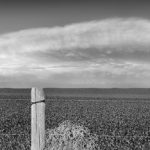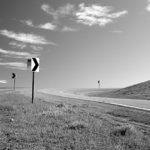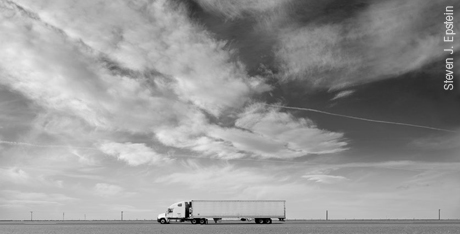The first time I saw Wyoming I hated it. I was 18 years old, driving cross-country from my home in the deciduous mitten of Michigan, across the northern plains to the mountain-rimmed valley of Missoula, Montana. My discomfort with Wyoming may have stemmed from severing the safety and comfort of my family or the isolation of being alone in the car for three days. Too many sunflower seeds, cigarettes, and cups of caffeine. Whatever the reason, Wyoming evoked feelings in me of bleak hopelessness and desperate loneliness.
I eyed the gas gauge, passing sign after sign announcing NO SERVICES.
All the way to the horizon, I saw nothing but sagebrush, fence posts, and the occasional herd of distant pronghorn. An unpainted clapboard house stood companionless atop a treeless mound, casting a long dreary shadow in the late August sun. I eyed the gas gauge, passing sign after sign announcing NO SERVICES, arrows pointing toward unseen towns with names like Recluse, Spotted Horse, Savageton and Bill. The winding ribbon of pavement dipped and rose, dipped and rose, changing color from the usual charcoal gray to a peculiar dusty pink. Michigan always held me in the palm of its hand; Wyoming only wanted to buck me off its back.
 Why would anyone want to live here, I wondered, turning up the music in an attempt to overwhelm the visual silence on the other side of the windshield. My Teton fantasies of snowcapped mountain peaks and whitewater rivers went unmet in this northeastern corner of Wyoming.
Why would anyone want to live here, I wondered, turning up the music in an attempt to overwhelm the visual silence on the other side of the windshield. My Teton fantasies of snowcapped mountain peaks and whitewater rivers went unmet in this northeastern corner of Wyoming.
In a few hours time, near the town of Buffalo, the Big Horn Mountains rose from the west and put an end to my unease. As the scenery changed, so did my feeling of discomfort. Anticipation grew to reach my new home in the Rockies. Wyoming, regardless, had made its first unforgettable impression.
At the time I wouldn’t have believed that I would eventually love Wyoming. Or that my love would stem from the same qualities of the landscape that made me feel so forlorn in the first place. Looking back, I wonder at the mystique of Open Space. What does it do to us, and why?
Eventually, I looked forward to being there, alone in the car, with nothing but space surrounding me.
There is an emotive relationship between atmosphere, body and soul. Places of open space seem able to tear deeper into us, into our subliminal minds, our subconscious minds, the part of us that is so often denied exposure. But it is a desolate land you might say, if you’d driven that stretch of I-90. And I wouldn’t argue that point. But I’ve grown to see something more there, qualities that make the land incomparably beautiful and of immeasurable value to our own sense of humanness. Through time and further experience, I have developed an ear for that visual silence.
 One year, one exact rotation of seasons from that day on the Interstate, I fell in love with a boy from Wyoming. His name was Noah, and he grew up on a cattle ranch in a town named Banner — population: 42. I made many trips to Wyoming for him, and with him, and with each trip I found myself growing more comfortable with open space. Eventually, I looked forward to being there, alone in the car, with nothing but space surrounding me. Open space, head space, heart space. Though my opinions about the landscape changed gradually, the effect was, in fact, drastic. I see ghostly things now on those monotonous, monochrome hills, things that aren’t there but used to be. I see thick herds of buffalo kicking up dust and wagon trains, teepees and packs of wolves. I feel the ground shake with the six-ton footfalls of Triceratops, as they graze through a grove of palm trees. And Pleistocene man hunting mastodon, on the same patch of earth where Crow, Arapahoe, Sioux and Shoshone would later stalk buffalo in much the same way. I see Crazy Horse coming over the rise, in maize-colored buckskin, feathers and bone beads. I see native grasses and dust storms, lightning bolts and prairie fires. This open space, I came to realize, ignites in me a sense of our place on the geologic timescale.
One year, one exact rotation of seasons from that day on the Interstate, I fell in love with a boy from Wyoming. His name was Noah, and he grew up on a cattle ranch in a town named Banner — population: 42. I made many trips to Wyoming for him, and with him, and with each trip I found myself growing more comfortable with open space. Eventually, I looked forward to being there, alone in the car, with nothing but space surrounding me. Open space, head space, heart space. Though my opinions about the landscape changed gradually, the effect was, in fact, drastic. I see ghostly things now on those monotonous, monochrome hills, things that aren’t there but used to be. I see thick herds of buffalo kicking up dust and wagon trains, teepees and packs of wolves. I feel the ground shake with the six-ton footfalls of Triceratops, as they graze through a grove of palm trees. And Pleistocene man hunting mastodon, on the same patch of earth where Crow, Arapahoe, Sioux and Shoshone would later stalk buffalo in much the same way. I see Crazy Horse coming over the rise, in maize-colored buckskin, feathers and bone beads. I see native grasses and dust storms, lightning bolts and prairie fires. This open space, I came to realize, ignites in me a sense of our place on the geologic timescale.
I can’t explain the chronology of my transformation, because I don’t entirely understand it. It happened without me really trying. What I do understand is that, like any transformation, it took a fateful combination of circumstance, time, openness and humility.
In Wyoming my attention was granted passage beyond the shallow foreground. My perception expanded from what was within reach to earth, sky and periphery. I have fallen in love with Wyoming, because it fulfills a primal need I did not know I had; a need for open space, both around and within me.
There is nowhere to hide on these barren facades. In her collection of essays, The Solace of Open Spaces, the poet and writer Gretel Ehrlich shows us what a place like Wyoming can give to a writer, to someone who makes it their business to see.
“The truest art I would strive for in any work,” she says, “would be to give the page the same qualities as earth: weather would land upon it harshly; light would elucidate the most difficult truths; wind would sweep away obtuse padding.”
What I hear her saying is that writing, which possesses the qualities of open space, does to the reader what my first impression of Wyoming did to me. It breaks us open.
There is wisdom in open spaces, waiting to be plucked by anyone willing to truly see and feel it. It reminds us that earth becomes flesh becomes earth. It is our keyhole glimpse into the great mystery. Big spaces translate into big ideas, ideas that elude language and, therefore, definition. My ruminations, however passionate, inevitably fall short. Open space, in any form, is where we can transcend, imagine and dream. It is where the struggle can momentarily end, and we stop trying to reach the next step, the next pinnacle, the next rung of the ladder. You do not need to be famous or perfect, it says. Forget yourself, your outfit, your bank account, your flab. There are no goals to reach here. Stop trying to know, and simply step into the mystery. To do this we must wait, through the discomfort, through our own resistance to it, through taking the first steps. I believe what we are doing when we allow ourselves to fall into these spaces is the terrifying trapeze act of letting go.
Open spaces, I believe, illuminate truths we do not always like seeing. We do not like to be reminded that our survival depends on grace and the kindness of others. We do not like to be reminded that we will eventually be gone and the earth will evolve with indifference to our having been here. But there is comfort to be mined from sensing our own insignificance; for it is in being reminded that we are small, that we may, for a moment, lose the need to be big.



